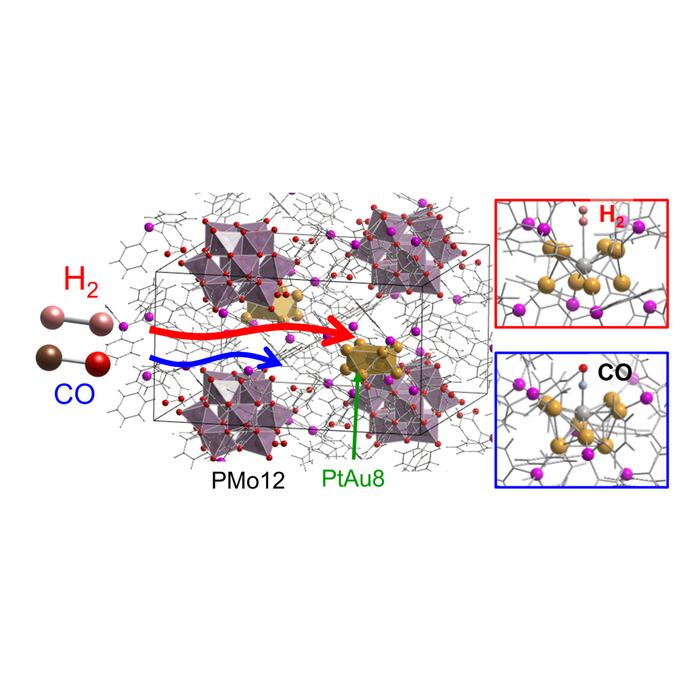
Tokyo Metropolitan University researchers have made significant strides in understanding the behavior of gases interacting with metal cluster-containing crystalline solids. The study focuses on a unique solid compound, [PtAu8(PPh3)8]-H[PMo12O40], identified as PtAu8-PMo12, demonstrating critical insights into how hydrogen and carbon monoxide are absorbed in structures composed of platinum and gold.
Using advanced techniques, including quick-scan X-ray absorption spectroscopy, the researchers captured detailed information on the dynamics of gas adsorption in real-time. This method allowed them to observe the interactions at intervals of 0.1 seconds, shedding light on how these gases influence the atomic structure of the solid. The research underscores the profound impact that nanoscale void dimensions have on gas transport phenomena, a finding with implications for the future development of materials in sensors and gas separation technologies.
The fundamental characteristics of ligand-protected metal clusters play a pivotal role in determining their efficacy as materials for catalysis. Ligand stabilization alters the geometrical arrangements of metal atoms, which presents distinct benefits compared to bulk metals. These clusters exhibit unique electronic properties, enhancing their performance in catalytic reactions. Among these applications, the hydrogen evolution reaction (HER) has captured significant attention, emphasizing the importance of studying how gases interact with these advanced materials.
The research team, led by Professor Seiji Yamazoe, investigated a distinct crown-motif structure involving a platinum atom centrally located among eight gold atoms. This arrangement, resembling a crown, demonstrates how the introduction of gas molecules modifies the solid’s properties. Specifically, their aim was to understand how the platinum-rich solid behaves when exposed to such gases, a process that is intricately tied to the void space within the material.
In examining the adsorption characteristics of hydrogen and carbon monoxide, the researchers noted that hydrogen diffuses through the nanoscale channels of PtAu8-PMo12 significantly faster than carbon monoxide. This disparity arises from differences in molecular size; hydrogen’s smaller size allows it to traverse the ultrathin channels efficiently. In contrast, carbon monoxide adheres more rigidly to the platinum atoms, resulting in irreversible binding that leads to considerable structural distortion.
The binding of hydrogen was reversible and rapid, a characteristic that could inform future innovations in catalytic processes. This property indicates the potential for applications where transient interactions are essential. The research team’s findings highlight the significance of manipulating molecular dimensions and void structures to enhance the performance of materials used in gas adsorption and catalytic reactions.
Moreover, the irreversible nature of carbon monoxide binding was particularly intriguing. The solid’s structure underwent a transformation, ultimately altering the crown-motif into a chalice-motif configuration. This change illustrates how tightly-bound gases can induce substantial alterations in atomic arrangement, which is crucial for understanding material behavior under various environmental conditions.
The implications of this study extend beyond gas adsorption to broader contexts in materials science. The investigation contributes to our understanding of how to engineer materials with tailored properties for specific applications, including chemical sensors and separation technologies. By elucidating the role of nanoscale voids, researchers can better design solids that accommodate the diffusion of various gases, paving the way for more efficient materials in industry and research.
In light of their findings, the team emphasizes the importance of continuing research on the structural behavior of metal clusters and their interactions with gas molecules. This work supports a larger initiative aimed at unlocking new functionalities within material design, particularly through structural reprogramming. Understanding how gas transport and diffusion interplay with atomic arrangements will guide the next generation of materials for advanced applications.
This research project received funding from various sources, including the NEDO Project and several JSPS KAKENHI grants. These resources facilitated the team’s endeavors, culminating in significant contributions to the field of materials science. Additionally, synchrotron radiation experiments conducted at SPring-8 provided critical data that complemented their theoretical calculations.
In conclusion, the study of gas adsorption in metal cluster-containing crystalline solids opens new avenues for research and application. The findings not only enhance our understanding of fundamental scientific principles but also promise practical implementations in the development of advanced materials for catalytic and separation processes. The manipulation of molecular size and void geometry may guide future endeavors in materials innovation, aligning with the evolving demands of industries reliant on efficient gas adsorption and catalysis.
Subject of Research: Gas adsorption in metal cluster-containing crystalline solids
Article Title: In situ QXAFS study of CO and H2 adsorption on Pt in [PtAu8(PPh3)8]-H[PMo12O40] solid
News Publication Date: 14-Nov-2024
Web References: http://dx.doi.org/10.1039/D4NR03785E
References: Data from the study itself and associated grants.
Image Credits: Credit: Tokyo Metropolitan University
Keywords
Gas adsorption, metal clusters, platinum, gold, hydrogen, carbon monoxide, catalytic processes, material science, nanostructures, synchrotron radiation, structural reprogramming, nanoscale voids.
Tags: advanced materials for sensorsatomic structure dynamicscatalytic properties of metal clusterscrystallinity in solid compoundsgas adsorption in metal clustersgas separation technologieshydrogen and carbon monoxide interactionshydrogen evolution reaction in catalysisligand-protected metal clustersnanoscale gas transport phenomenaplatinum and gold nanostructuresreal-time spectroscopy techniques





